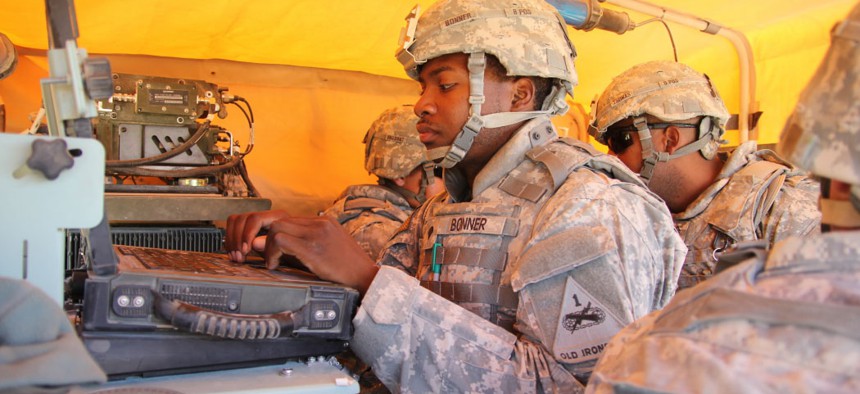
Army's latest challenge: cyber awareness on the battlefield
The service is focusing on a software-based prototype model associated with cyber situational awareness.
In the latest of its Cyber Innovation Challenges, the Army is focusing on industry solutions for a software-based prototype model that can deliver a complete cyber situational awareness picture on the battlefield.
According to a notice issued this week, the challenge intends to “evaluate the technical feasibility of a risk-based Cyber Situational Awareness (SA) capability tool at echelon.” The goal is a software-based cyber SA prototype that provides commanders at the brigade level with “tailorable and time-relevant SA data, which facilitate risk-based decision-making.”
As such, the solution would have to give commanders an understanding of cyber elements with an area of responsibility—friendly and unfriendly—while also supporting Defense Department Information Network offensive and defensive operations.
“This Cyber Innovation Challenge effort is focused specifically on the commander's ability to visualize the cyber risk posture associated with the networks and assets supporting the mission space,” the notice states. “The visualization capability includes, but is not limited to, various types of data sources such as network topology, friendly asset and open-source information, key-user and threat activity information, and overlays of cyber assets on terrain, while supporting interoperability with external mission-command systems.”
Army cyber officials discussed what the force is looking for in terms of cyber situational awareness during a recent industry event. “There are two discrete components that this [program executive office] is specifically engaged in; one is a situation understanding of our spectrum,” Mark Kitz, acting director of System of Systems Engineering, PEO for Intelligence, Electronic Warfare and Sensors, said at an AFCEA NOVA event in April. “Where are we communicating, when are we jamming, when are we operating in spectrum so that we can operate effectively, how do we coordinate those operations so that whatever effect we’re trying to deliver has a higher probability of success?”
Kitz also discussed the need for data and information. “Support to the commander is dependent upon data and information. And you could imagine it’s relatively common sense that cyber is another source of information for our intelligence professionals to provide a better picture of the situation of the environment that we’re faced with…So those two aspects of cyber situation understanding/situation awareness are really where we’re focusing our efforts on,” he added.
The Army is pushing forward with a this new concept of cyber situational understanding, “a shift away from cyber situational awareness, which puts more emphasis on applying analysis and judgement on operational and mission variables to facilitate decision making,” Portia Crowe, director of Cyber ops/CIO for PEO Command Control Communications Tactical, said at the same event.
Last week, the Army hosted an industry day as part of another innovation challenge at the newly established DOD Silicon Valley hub – Defense Innovation Unit Experimental – for managing micro cloud solutions. Previous challenges have sought to close cyber awareness gaps, and awarded contracts for next-generation prototypes to inform specifications prior to fielding decisions.
An industry day is planned for mid-November for the cyber situational awareness challenge, with additional details forthcoming.
Responses for the notice issued this week are due April 16.